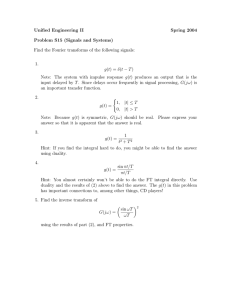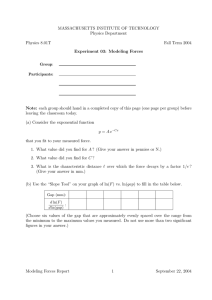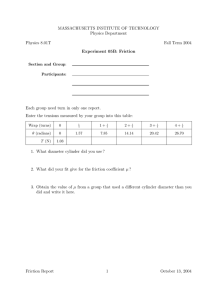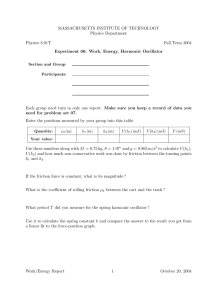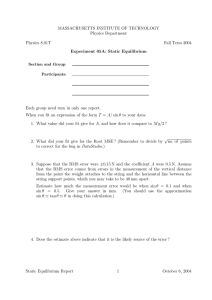µ m F no friction
advertisement
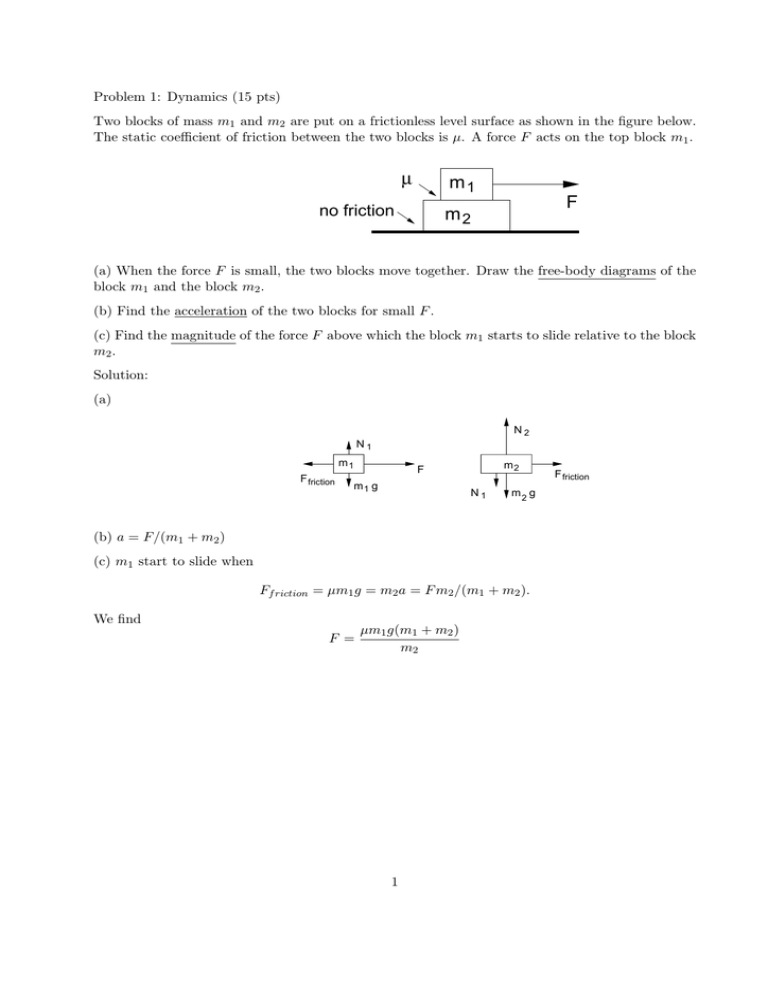
Problem 1: Dynamics (15 pts) Two blocks of mass m1 and m2 are put on a frictionless level surface as shown in the figure below. The static coefficient of friction between the two blocks is µ. A force F acts on the top block m1 . µ m1 no friction F m2 (a) When the force F is small, the two blocks move together. Draw the free-body diagrams of the block m1 and the block m2 . (b) Find the acceleration of the two blocks for small F . (c) Find the magnitude of the force F above which the block m1 starts to slide relative to the block m2 . Solution: (a) N2 N1 m1 F friction m2 F m1 g N1 m2 g (b) a = F/(m1 + m2 ) (c) m1 start to slide when Ff riction = µm1 g = m2 a = F m2 /(m1 + m2 ). We find F = µm1 g(m1 + m2 ) m2 1 F friction Problem 2: Circular motion (15 pts) A car of mass m = 1000kg is traveling around a flat circular race track of radius 100m. The static coefficient of friction between the tire and the road (against transverse motion) is µ = 0.5. (Assume g = 10m/s2 ) (a) How fast can the car travel before it starts to skid? Express the speed in the units of m/s. (b) What is the angular velocity ω of the car at the speed calculated in (a). (c) The driver of the car wants to drive faster. He loads 500kg of weight into the car to increase the friction force. Now how fast can the car travel without skidding? Solution: (a) The max speed of the car should satisfy m We find v= √ µgr = √ v2 = µmg r √ 0.5 ∗ 100 ∗ 10 = 10 5m/s = 22m/s (b) The angular velocity is ω = v/r = 0.22/s (c) v does not depend on the mass. So the max speed is not changed. 2 Problem 3: Balance and energy (15 pts) A block of mass m is tied to two strings as shown in the figure below. Each string has a length L. √ The angle θ = 30◦ . (sin θ = 1/2 and cos θ = 3/2.) Assume the strings are massless. θ θ L θ L L m m (a) Draw the free-body diagram of the block. (b) Find the tension of each string. (c) We cut one string and the block starts to swing down. Find the speed of the block when it reaches the lowest point. (d) Find the tension in the string when the block reaches the lowest point. Solution: (a) T T mg (b) From the balance of the force in the vertical direction, we find mg = 2T sin θ = T Thus T = mg. (c) The change in the potential energy is mg(L − L sin θ) = mgL/2. Thus mgL 1 mv 2 = 2 2 We find v= gL (d) The tension minus weight should provide the acceleration for the circular motion: T − mg = m v2 L So T = mg + mg = 2mg 3 Problem 4: Power A small car’s engine can deliver 90kW of power (about 120hp). The car’s mass is 1000kg. (Assume g = 10m/s2 ) θ (a) (b) (a) Assume the total resistive force is proportional to the velocity: Ff riction = αv. The drag coefficient α is α = 100N s/m. How fast can the car move on a level road? Express the speed in the units of m/s. (b) How fast can the car travel up a slope if we ignore all friction? The angle of the slope is θ (sin(θ) = 3/5 and cos(θ) = 4/5). Express the speed in the units of m/s. Solution: (a) From P = vFf riction , we find P = αv 2 or v = P/α = 90000/100 = 30m/s = 108km/hr (b) From Work=P ∗ ∆t = mg∆h = mg∆x sin θ = mgv∆t sin θ, we find P = mgv sin θ or v= 90000 P = = 15m/s = 54km/hr mg sin θ 1000 ∗ 10 ∗ 3/5 4
